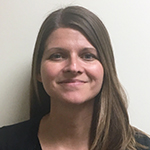 Dr. Lisa Inglis is an assistant professor of Physical Therapy and the coordinator of the pre-professional phase academic curriculum for the program. We spoke to her about her role at Daemen and how physical therapy is being used to treat Parkinson’s disease (PD).
Dr. Lisa Inglis is an assistant professor of Physical Therapy and the coordinator of the pre-professional phase academic curriculum for the program. We spoke to her about her role at Daemen and how physical therapy is being used to treat Parkinson’s disease (PD).
How long have you been at Daemen University?
I started working at Daemen in the fall of 2016. I work in the fifth year, second year of the professional phase, teaching in most of the neuromuscular practice courses. Adult NM neurobiology. A lot of the patient experiences we do are in NM rehab courses and in a course called clinical exposure, where patients are brought on campus.
When many think of treatment, they think of pharmaceutical and surgical interventions. What is Physical Therapy’s relationship to the treatment of Parkinson’s disease?
Treatment should really be done in conjunction with medication and, if appropriate, surgical interventions. But it’s one place where we really are learning that exercise is medicine. For sure, we know that our patients with Parkinson’s stay healthier longer, are able to move longer and better the more active that they are.
There’s some preliminary animal study evidence that exercise might actually delay disease progression by preserving the neurons for longer. That is not confirmed in human studies yet just because they’re still working on good bio-markers. But we know enough about the physical functioning and the improvements that we can see through exercise that it should really be something that our patients with Parkinson’s do.
I usually tell my new patients, “you have Parkinson’s, that means you have to take medicine every day for the rest of your life. It also means you should also have a healthy dose of exercise every day for the rest of your life.”
There are strong clinical practice guidelines out there, which came out in 2022, really guiding clinicians to try to standardize that care and ensure that it’s accessible to all patients with Parkinson’s.
Can you describe the kind of treatment that they’d be getting with a PT?
Close to diagnosis, we really can be fairly aggressive in our treatment, so they should be doing a combination of endurance exercise, either fast walking or cycling, depending on what’s safe for them, balance training, strengthening exercises, flexibility exercises. So they really need a wide variety of either independent exercises or PT early on, and there’s lots of community programs that we can liaise to, such as Parkinson’s dance, and Parkinson’s yoga, and Parkinson’s boxing and things like that. We try to collaborate with them because, like I said, they need to do exercise every day, but you can’t see your PT every day.
As PD progresses, we really start to focus in on providing specific, ongoing PT for those challenges that they’re having. We really focus on function. As people start to have difficulty with their walking or falls or getting in and out of bed, climbing the stairs, we can really do some targeted interventions through exercise that help them to regain that function or maintain that function in a better way.
Can you describe the work you have done in relation to Parkinson’s research?
We’ve had a couple of projects since I’ve been here. The first year I was here we followed a boxing program to look at their outcomes. We had a PD group exercise clinic in 2018, which got put on hold to Covid. We’ve also had a long-going project where we’re looking to validate a couple of new standardized output measures, where we’re looking at backwards gait and obstacle course negotiation as potential falls risk predictors for patients with PD.
The nice thing about that is not only is it contributing to research, but when we’re actually doing research on patients with PD, then I have a student research group with me. They actually get to see that population.
I’ve had students in my research group who have gone on to specialize in that area, get advanced certifications after graduation, and become leaders in the field because of that experience that they had in their schooling.
What role does this play for you in the classroom?
I like to be really efficient in my research and so, of course, I have my own publication goals in mind. But also, I’m teaching my students and so I want them to have a good experience. And then I also try to look at how can I make this study of value to the participants who are coming in. So these patients with PD, are they getting something out of their time here?
I think we ask a lot sometimes of our clinical populations to be in this study, and this study, and this study. So I like to make sure that there’s something of value in it for everybody. So, for example, with the outcome measure study that we’re doing, we give them a summary of their falls risk at the end of that study. So they’re getting a full screen out of it, my students are getting hands-on experience doing these outcomes measures with someone with PD, and at the end, we have data that they can present at the symposium and that we can go on to publish after we’ve collected that.
I think it’s an efficient way to tick a lot of boxes; we’re trying to get scholarships, we’re trying to teach, and we’re trying to help the clinical populations at the same time.
